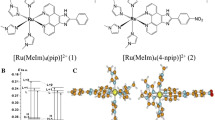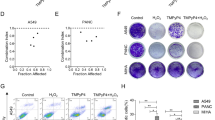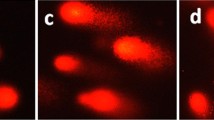Abstract
Purpose. The G-quadruplex ligand 3,3′-diethyloxadicarbocyanine iodide (DODC) was reported to enhance the apoptotic potency of pheochromocytoma PC-12 and leukemia HL-60 cells through the inhibition of telomerase activity. In this study, a mitochondrion-mediated apoptotic pathway was demonstrated as another cytotoxic mechanism for DODC action.
Methods. 3-(4,5-dimethylthiazol-2-yl)-2,5-diphenyltetrazolium bromide (MTT) and DNA laddering assays were performed to exhibit the cytotoxicity and apoptosis-inducing activity of DODC. Telomeric repeat amplification protocol (TRAP) assay was used to evaluate the effect of DODC on cellular telomerase. The mitochondrial uptake of probe 3,3′-dihexyloxacarbocyanine iodide was measured by flow cytometry. The mitochondrial proteomes were analyzed by two-dimensional gel electrophoresis and matrix-assisted laser desorption/ionization-time of flight mass spectrometry (MALDI-TOF MS). Western blot analyses were adopted to demonstrate the change of the distribution of mitochondrial proteins.
Results. DODC alone was able to induce apoptotic cell death but not decrease of telomerase activity in nasopharyngeal carcinoma NPC-TW01 cells. Instead, we found evidence that DODC significantly affected cellular mitochondria. DODC inhibited the uptake of another mitochondrial probe 3,3′-dihexyloxacarbocyanine iodide. By proteomic comparative analysis, we found that DODC induced the increase of prohibitin level in the mitochondria, indicating the occurrence of mitochondrial perturbation. Moreover, DODC was found to induce the levels of p53 and an 18-kDa truncated Bax on mitochondria, which in turn potentiated the release of cytochrome c for activation of caspases.
Conclusions. DODC induces NPC-TW01 cell apoptosis via a mitochondrion-mediated mechanism. This paper demonstrates another cytotoxic mechanism of DODC other than inhibition of telomerase.
Similar content being viewed by others
REFERENCES
C. W. Greider. Telomere length regulation. Annu. Rev. Biochem. 65:337-365 (1996).
G. N. Parkinson, M. P. H. Lee, and S. Neidle. Crystal structure of parallel quadruplexes from human telomeric DNA. Nature 417:876-880 (2002).
A. M. Zahler, J. R. Williamson, T. R. Cech, and D. M. Prescott. Inhibition of telomerase by G-quartet DNA structures. Nature 350:718-720 (1991).
R. J. Harrison, S. M. Gowan, L. R. Kelland, and S. Neidle. Human telomerase inhibition by substituted acridine derivatives. Bioorg. Med. Chem. Lett. 9:2463-2468 (1999).
J. F. Riou, L. Guittat, P. Mailliet, A. Laoui, E. Renou, O. Petitgenet, F. Megnin-Chanet, C. Helene, and J. L. Mergny. Cell senescence and telomere shortening induced by a new series of specific G-quadruplex DNA ligands. Proc. Natl. Acad. Sci. U. S. A. 99:2672-2677 (2002).
J. L. Mergny, J. F. Riou, P. Mailliet, M-P. Teulade-Fichou, and E. Gilson. Survey and summary. Natural and pharmacological regulation of telomerase. Nucleic Acids Res. 30:839-865 (2002).
T. K. Das and S. Mazumdar. Effect of adriamycin on the boundary lipid structure of cytochrome c oxidase: pico-second time-resolved fluorescence depolarization studies. Biophys. Chem. 86:15-28 (2000).
Q. Chen, I. D. Kuntz, and R. H. Shafer. Spectroscopic recognition of guanine dimeric hairpin quadruplexes by a carbocyanine dye. Proc. Natl. Acad. Sci. U. S. A. 93:2635-2639 (1996).
W. Fu, J. G. Begley, M. W. Killen, and M. P. Mattson. Anti-apoptotic role of telomerase in pheochromocytoma cells. J. Biol. Chem. 274:7264-7271 (1999).
J. M. Kraveka, B. Ogretmen, J. C. Barredo, and A. R. Safa. Association of telomerase activity with drug resistance in HL-60 and its multidrug resistant derivatives HL-60/adr and HL-60/vcr cells. Proc. Am. Assoc. Cancer Res. 41:2864(2000).
T-S. Huang, C-H. Shu, Y. Chao, and L-T. Chen. Evaluation of GL331 in combination with paclitaxel: GL331's interference with paclitaxel-induced cell cycle perturbation and apoptosis. Anti-Cancer Drug. 12:259-266 (2001).
C-C. Lee and T-S. Huang. A novel topoisomerase II poison GL331 preferentially induces DNA cleavage at (C/G)T sites and can cause telomere DNA damage. Pharm. Res. 18:846-851 (2001).
S. Lin, H-C. Huang, L-L. Chen, C-C. Lee, and T-S. Huang. GL331 induces down-regulation of cyclin D1 expression via enhanced proteolysis and repressed transcription. Mol. Pharmacol. 60:768-775 (2001).
T. Hishita, S. Tada-Oikawa, K. Tohyama, Y. Miura, T. Nishihara, Y. Tohyama, Y. Yoshida, T. Uchiyama, and S. Kawanishi. Caspase-3 activation by lysosomal enzymes in cytochome c-independent apoptosis in myelodysplastic syndrome-derived cell line P39. Cancer Res. 61:2878-2884 (2001).
J. Yang, X. Liu, K. Bhalla, C. N. Kim, A. M. Ibrado, J. Cai, T. Peng, D. P. Jones, and X. Wang. Prevention of apoptosis by Bcl-2: release of cytochrome c from mitochondria blocked. Science 275:1129-1132 (1997).
T-S. Huang, C-C. Lee, A-C. Chang, S. Lin, C-C. Chao, Y-S. Jou, Y-W. Chu, C-W. Wu, and J. Whang-Peng. Shortening of microsatellite deoxy(CA) repeats involved in GL331-induced down-regulation of matrix metalloproteinase-9 gene expression. Biochem. Biophys. Res. Commun. 300:901-907 (2003).
W. E. Thompson, A. Branch, J. A. Whittaker, D. Lyn, M. Zilberstein, K. E. Mayo, and K. Thomas. Characterization of prohibitin in a newly established rat ovarian granulosa cell line. Endocrinology 142:4076-4085 (2001).
N. D. Marchenko, A. Zaika, and U. M. Moll. Death signal-induced localization of p53 protein to mitochondria. A potential role in apoptotic signaling. J. Biol. Chem. 275:16202-16212 (2000).
S. Kharbanda, S. Saxena, K. Yoshida, P. Pandey, M. Kaneki, Q. Wang, K. Cheng, Y. N. Chen, A. Campbell, T. Sudha, Z. M. Yuan, J. Narula, R. Weichselbaum, C. Nalin, and D. Kufe. Translocation of SAPK/JNK to mitochondria and interaction with Bcl-x(L) in response to DNA damage. J. Biol. Chem. 275:322-327 (2000).
P. K. Majumder, P. Pandey, X. Sun, K. Cheng, R. Datta, S. Saxena, S. Kharbanda, and D. Kufe. Mitochondrial translocation of protein kinase C delta in phorbol ester-induced cytochrome c release and apoptosis. J. Biol. Chem. 275:21793-21796 (2000).
J. K. McClung, D. B. Danner, D. A. Stewart, J. R. Smith, E. L. Schneider, C. K. Lumpkin, R. T. Dell'Orco, and M. J. Nuell. Isolation of a cDNA that hybrid selects antiproliferative mRNA from rat liver. Biochem. Biophys. Res. Commun. 164:1316-1322 (1989).
L. G. J. Nijtmans, L. de Jong, M. Artal Sanz, P. J. Coates, J. A. Berden, J. Willem Back, A. O. Muijsers, H. van der Spek, and L. A. Grivell. Prohibitins act as a membrane-bound chaperone for the stabilization of mitochondrial proteins. EMBO J. 19:2444-2451 (2000).
S. Shimizu, T. Ide, T. Yanagida, and Y. Tsujimoto. Electrophysiological study of a novel large pore formed by Bax and the voltage-dependent anion channel that is permeable to cytochrome c. J. Biol. Chem. 275:12321-12325 (2000).
N. Yanase, E. Takada, I. Yoshihama, H. Ikegami, and J. Mizuguchi. Participation of Bax-alpha in IFN-alpha-mediated apoptosis in Daudi B lymphoma cells. J. Interferon Cytokine Res. 18:855-861 (1998).
D. E. Wood, A. Thomas, L. A. Devi, Y. Berman, R. C. Beavis, J. C. Reed, and E. W. Newcomb. Bax cleavage is mediated by calpain during drug-induced apoptosis. Oncogene 17:1069-1078 (1998).
H. Toyota, N. Yanase, T. Yoshimoto, M. Moriyama, T. Sudo, and J. Mizuguchi. Calpain-induced Bax-cleavage product is a more potent inducer of apoptotic cell death than wild-type Bax. Cancer Lett. 189:221-230 (2003).
M. Mihara, S. Erster, A. Zaika, O. Petrenko, T. Chittenden, P. Pancoska, and U. M. Moll. p53 has a direct apoptogenic role at the mitochondria. Mol. Cell 11:577-590 (2003).
X. Wang. The expanding role of mitochondria in apoptosis. Genes Dev. 15:2922-2933 (2001).
C. Brodie and P. M. Blumberg. Regulation of cell apoptosis by protein kinase C δ. Apoptosis 8:19-27 (2003).
Author information
Authors and Affiliations
Corresponding author
Rights and permissions
About this article
Cite this article
Li, CP., Huang, JH., Chang, AC. et al. A G-Quadruplex Ligand 3,3′-Diethyloxadicarbocyanine Iodide Induces Mitochondrion-Mediated Apoptosis But Not Decrease of Telomerase Activity in Nasopharyngeal Carcinoma NPC-TW01 Cells. Pharm Res 21, 93–100 (2004). https://doi.org/10.1023/B:PHAM.0000012166.44521.1f
Issue Date:
DOI: https://doi.org/10.1023/B:PHAM.0000012166.44521.1f




